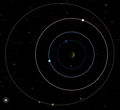Difference between revisions of "Jool/pl"
| Line 36: | Line 36: | ||
[[File:JoolAtmosphere.png|thumb|right|Hamowanie atmosferyczne nad Jool.]] | [[File:JoolAtmosphere.png|thumb|right|Hamowanie atmosferyczne nad Jool.]] | ||
| − | + | Mimo, że Jool ma promień 10x większy niż [[Kerbin]], jego atmosfera zaczyna się tylko 2x wyżej (138.2). Jest również bardzo gęsta, dobrze nadaje się do hamowania atmosferycznego. Orbitowanie zaraz ponad atmosferą daje okres orbitalny równy 94.7437 minutom, i prędkość 6,785 m/s. Schodzenie poniżej 60Km zazwyczaj nie jest konieczne przy manewrach hamowania atmosferycznego. | |
| + | Generalnie, ciśnienie atmosferyczne na Jool dla wysokości wyrażonej w metrach to:<math>p_j = 15\ e^{-wysokosc/9000}</math> | ||
| − | + | Bliżej "powierzchni" fizyka gry zaczyna wykazywać błędy. Ze względu na bardzo gęstą atmosferę, prędkość maksymalna jest tak niska, że lżejsze pojazdy nie potrzebują spadochronów ani napędu. Lądowanie na powierzchni jest możliwe, chociaż pojazdy zostaną rozerwane przez [[Krakena]]. Obiekty stykające się z powierzchnią Jool będą podskakiwać i odbijać się od niej. Można również wyprowadzić Kerbonautę na EVA po powierzchni. Z powodu atmosfery i grawitacji, lądowanie na Jool jest ostateczne - z planety nie da się wystartować. | |
| − | |||
| − | |||
| − | |||
|} | |} | ||
| − | == | + | == Naturalne satelity == |
{| | {| | ||
| | | | ||
| − | [[File:JoolLaythe.png|thumb|right| | + | [[File:JoolLaythe.png|thumb|right|Pokryty oceanem, księżyc [http://kspwiki.nexisonline.net/wiki/Laythe/pl Laythe], W trakcie przejścia przez tarczę Jool.]] |
| − | Jool | + | Jool posiada 4 naturalne satelity: |
| − | * | + | * Pokryty oceanem [http://kspwiki.nexisonline.net/wiki/Laythe/pl Laythe], chwili obecnej jedyny księżyc w posiadający atmosferę. Jest najbliższym i drugim co do wielkości księżycem Jool. Ze względu na swój krótki okres orbitalny jest dosyć trudny do przechwycenia. Wraz z [http://kspwiki.nexisonline.net/wiki/Eve/pl Eve], Laythe jest ciałem najbardziej podobnym do [http://kspwiki.nexisonline.net/wiki/Kerbin/pl Kerbinu]. |
* The ice moon [[Vall]], which is the third largest and second closest. Its orbital path and velocity sit almost exactly between Layth and Tylo. | * The ice moon [[Vall]], which is the third largest and second closest. Its orbital path and velocity sit almost exactly between Layth and Tylo. | ||
Revision as of 17:59, 1 November 2012
Jool is a gazowym olbrzymem i piątą planetą orbitującą wokół gwiazdy Kerbol. Jest najodleglejszą z pięciu planet, i najtrudniejszą do osiągnięcia. Jest jednak jednym z najbardziej interesujących celów misji ze względu na swój skomplikowany układ czterech księżyców:Laythe, Vall, Tylo i Bop. Pozwala to na wiele manewrów przechwycenia przez poszczególne księżyce, i dokonywanie manewrów spowalniania/przyspieszania bez zużywania ΔV.
Atmosfera
|
Mimo, że Jool ma promień 10x większy niż Kerbin, jego atmosfera zaczyna się tylko 2x wyżej (138.2). Jest również bardzo gęsta, dobrze nadaje się do hamowania atmosferycznego. Orbitowanie zaraz ponad atmosferą daje okres orbitalny równy 94.7437 minutom, i prędkość 6,785 m/s. Schodzenie poniżej 60Km zazwyczaj nie jest konieczne przy manewrach hamowania atmosferycznego. Generalnie, ciśnienie atmosferyczne na Jool dla wysokości wyrażonej w metrach to: Bliżej "powierzchni" fizyka gry zaczyna wykazywać błędy. Ze względu na bardzo gęstą atmosferę, prędkość maksymalna jest tak niska, że lżejsze pojazdy nie potrzebują spadochronów ani napędu. Lądowanie na powierzchni jest możliwe, chociaż pojazdy zostaną rozerwane przez Krakena. Obiekty stykające się z powierzchnią Jool będą podskakiwać i odbijać się od niej. Można również wyprowadzić Kerbonautę na EVA po powierzchni. Z powodu atmosfery i grawitacji, lądowanie na Jool jest ostateczne - z planety nie da się wystartować. |
Naturalne satelity
 Pokryty oceanem, księżyc Laythe, W trakcie przejścia przez tarczę Jool. Jool posiada 4 naturalne satelity:
Laythe, Vall, and Tylo are in a Laplace resonance, with orbital periods of 1:2:4 respectively. Despite the fact that the moons can easily eclipse both each other and Jool, they do not. |
Gallery
Changes
- Initial Release



